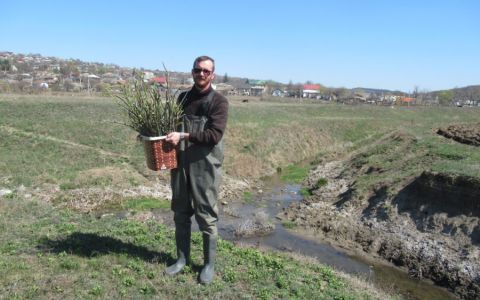The village of Țipova is located on the right bank of the Dniester river in Rezina district. This place is famous in Moldova and abroad for its cave Orthodox monastery considered one of the biggest in southeastern Europe and for its beautiful canyons of Țipova natural landscape reserve.
The first written mentions of Țipova cave monastery date back to the 15th century, but the time of its foundation, according to researchers, is the 11th century. The underground cells and the monastery itself were dug into the rock in several tiers. In 1975 Țipova cave monastery complex was taken under state protection. Today it is a branch of the National Museum of Ethnography and Natural History (MNEIN). The complex has been partially restored and is open to the public.
The natural landscape reserve Țipova (306 hectares) is located on the rugged right bank of the Dniester, between the villages of Horodişte and Țipova (com. Lalova) in Rezina district. The main part of the landscape is a canyon 150–200 m deep with grottoes, caves and many picturesque waterfalls up to 10–16 m high. There are more than 10 springs on the territory of the reserve. The average age of trees in the reserve is 35-100 years, but there are several oaks of 110-210 years old.
The Țipova natural landscape reserve includes habitat of European significance 9170(B) – mixed forests dominated by Quercus robur. The reserve belongs to the key areas of local significance of the national Ecological Network of the Republic of Moldova.
33 species of plants, 15 rare or vulnerable animals and also 28 species of birds protected at the state and international levels have been identified in Țipova natural landscape.
On the high ledges of rocks from the side of the village of Horodişte, the ruins of an earthen fortress of the Geto-Dacians have been preserved. Many traces of Trypillian settlements were also discovered in this area.
Țipova thus has a great potential for soft tourism. However, the village is so far struggling with the growth of unorganised tourism. The local nature reserve has, despite a number of endangered species, no precise boundaries, administration or guard, or a budget for administration and adequate infrastructure or signs, which is reflected in the destruction of nature by cars, accumulation of garbage, illegal camping or lighting fires. The situation got worse during pandemia when the flow of inner unorganized tourism has increased significantly.
A local NGO, AO Centrul de Dezvoltare Regională "SOL", led by Maria Gurscaia, brought together active representatives of the local community and tries to protect, develop and promote this region. AO "SOL" organises activities relating to nature protection and light tourism infrastructure development. They have amended a landfill next to the village and a spring and a pool in the canyon, sign-posted tourist trails, elaborated ecotouristic guides and installed information boards. They also organise ecofestivals and other educational/ecological events in the village for locals and for coming tourists. AO "SOL" considers it is important to develop the culture of sustainable tourism among all categories of tourists in order to make the touristic experience more constient for people and more friendly for the nature.







